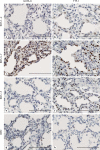Expression of Transcription Factor GATA-6 in Alveolar Epithelial Cells Is Linked to Neonatal Lung Disease
- PMID: 21071980
- PMCID: PMC2992637
- DOI: 10.1159/000317827
Expression of Transcription Factor GATA-6 in Alveolar Epithelial Cells Is Linked to Neonatal Lung Disease
Abstract
Background: Premature birth and respiratory distress syndrome (RDS) are risk factors for disturbed lung development and bronchopulmonary dysplasia (BPD). The molecular mechanisms related to prematurity and BPD remain largely unknown. Epithelial expression of the transcription factor GATA-6 has been implicated in normal and abnormal murine lung development.
Objectives: The possible involvement of GATA-6 in the normal development and in RDS and BPD was investigated in the human and baboon lung.
Methods: Immunohistochemistry was used to study the expression of GATA-6 and thyroid transcription factor 1 in lung specimens from different age groups of human and baboon fetuses and newborns with lung disease. Furthermore, the regulatory role of TGF-β₁ in GATA-6 expression was investigated in human pulmonary epithelial cell lines using RT-PCR.
Results: GATA-6 expression increased in the developing human airway epithelium along with advancing gestation, but diminished to negligible at birth. In RDS, GATA-6 expression was enhanced at 5-7 days after birth, and decreased thereafter. In BPD, the expression of GATA-6 in alveolar epithelial cells was low. These results were confirmed and extended using an established baboon model of prematurity. The in vitro experiments revealed that TGF-β₁ induces GATA-6 and thyroid transcription factor 1 expression in lung epithelial cells.
Conclusions: Our results suggest that the expression of GATA-6 at the early stages of the preterm lung may be related to impaired postnatal alveolar development.
Copyright © 2010 S. Karger AG, Basel.
Figures




References
-
- Verma RP. Respiratory distress syndrome of the newborn infant. Obstet Gynecol Surv. 1995;50:542–555. - PubMed
-
- Speer CP. Inflammation and bronchopulmonary dysplasia: a continuing story. Semin Fetal Neonatal Med. 2006;11:354–362. - PubMed
-
- Jobe AJ. The new BPD: an arrest of lung development. Pediatr Res. 1999;46:641–643. - PubMed
-
- Abman SH. Bronchopulmonary dysplasia: ‘a vascular hypothesis’. Am J Respir Crit Care Med. 2001;164:1755–1756. - PubMed
-
- Alejandre-Alcazar MA, Kwapiszewska G, Reiss I, Amarie OV, Marsh LM, Sevilla-Perez J, Wygrecka M, Eul B, Kobrich S, Hesse M, Schermuly RT, Seeger W, Eickelberg O, Morty RE. Hyperoxia modulates TGF-beta/BMP signaling in a mouse model of bronchopulmonary dysplasia. Am J Physiol Lung Cell Mol Physiol. 2007;292:L537–L549. - PubMed
Publication types
MeSH terms
Substances
Grants and funding
LinkOut - more resources
Full Text Sources
Medical

